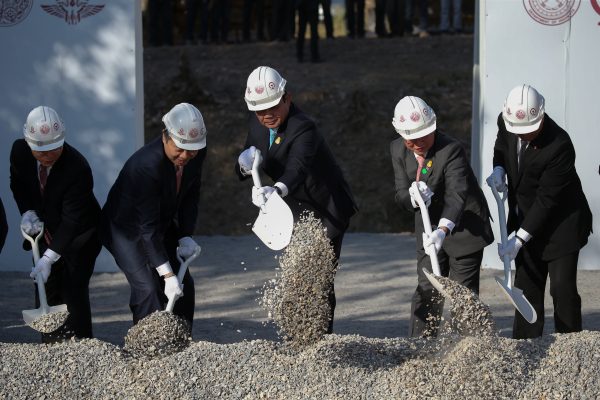The most recent measure, ‘Thailand 4.0’, represents a combination of promoting industrial transformation and establishing an economic corridor in eastern Thailand.
Ten newly targeted industries were selected to serve as fresh and more sustainable growth engines. The first five — new-generation automotive technologies, smart electronics, affluent, medical and wellness tourism, agriculture and biotechnology, and food for the future — are usually referred to as the five ‘S-curve’ industries and the others — manufacturing robotics, medical services and innovation, aviation and logistics, biofuels and biochemicals, and digital industries — as the five ‘new S-curve’ industries.
The Eastern Economic Corridor (EEC) will support the country’s industrial transformation and straddles three eastern provinces — Chonburi, Rayong and Chachoengsao — off of the Gulf of Thailand. To support the EEC in achieving this industrial transformation, the government is undertaking two key measures.
First, the Thai government is offering greater investment incentives to help make the EEC competitive. Investors in the EEC are now eligible for income tax breaks for up to 15 years, a reduced personal income tax rate of 17 per cent and a 50 per cent reduction in corporate income tax rates over a maximum of 5 years. These measures lie over and above the existing exemptions and benefits extended by the government’s Board of Investment (BOI) such as access to long-term land leases, import duty exemptions and work visas.
The second measure is the undertaking of infrastructure investment projects. This includes launching a third international airport (U-Tapao), expanding the Laem Chabang seaport (Laem Chabang Phase 3) and extending land transport networks (high-speed trains, double-track railways and highways) in the EEC area — representing a total investment of US$43 billion over 2019–2025. These projects have been undertaken through public–private partnership platforms. While other measures have been implemented, such as area-specific clusters in the EEC (innovation and digital technology), human resource initiatives and promoting the use of digital technology, their impact remains somewhat piecemeal and there are uncertainties about their continuation.
Thailand 4.0 represents the current government’s hopes for enhancing productivity and boosting economic growth. Yet, there are at least two challenges to be overcome.
First, picking certain industries for industrial transformation is a risky policy for a small open economy like Thailand to pursue. In fact, six out of the ten industries under Thailand 4.0 are similar to those proposed under the Made in China 2025 initiative, reflecting a technological leap-frogging policy sentiment. This strategy could leave many industries behind as the ten targeted industries account for only 50 per cent of gross manufacturing output. This uncertainty is even worse in an era of disruptive technology.
Many government agencies claim that they can create high value-added goods and services for the economy and are in a better position than others to harness digital technological advances. This seems to contradict the growing evidence that all industries can benefit from technological advances. This is immensely relevant for Thailand whose industrialisation is arguably the most broad based regionally. The coming challenge is how to make a transition from the current stage to the planned outcome. Otherwise, this transition will be associated with high adjustment costs and is unlikely to achieve inclusive economic growth.
Second, despite only taking place in certain areas, the EEC’s infrastructure projects are essential for Thailand, where the latest comprehensive infrastructure projects took place in the mid-1980s. The EEC’s effect on productivity and economic growth will be positive in the short-to-medium-term, but the magnitude will be conditioned by how fast the projects are implemented. This is the upcoming policy challenge for the newly-formed government.
Setting up a one-stop service agency like the EEC Office (EECO) to handle multi-government agency involvement is inadequate for overcoming policy uncertainty, as the experience of the Northern Corridor Economic Region (NCER) in Malaysia suggests. An investment delay of at least one year for the project involving U-Tapao airport and the high-speed train connecting three international airports can be seen as evidence. The project expanding the capacity of Laem Chabang port (Phase 3), which was supposed to begin in 2018, is still struggling to select a suitable partner as of early 2020.
These delays signal policy uncertainty issues for investors. Foreign direct investors often adopt a ‘wait-and-see’ mode, regardless of the investment incentives. This is evidenced by an increase of FDI inflows to Thailand from 2016–2018 that were largely driven by mergers and acquisitions, whereas greenfield FDI inflows remained stagnant. What’s more, the number of BOI promoted projects from 2017–2019 did not change noticeably and were largely funded by Thais.
Thailand 4.0 has the potential to promote productivity enhancements and short-to-medium-term economic growth, but the policy measures must be implemented wisely. The challenges faced by the initiative need more targeted action from the government to allow it to fully realise its potential and to minimise the adjustment costs of economic transformation.
The EECO is clearly inadequate to overcome policy uncertainty. An independent, transparent and comprehensive monitoring system for the EEC’s progress is needed to address the initiative’s problems as well as to enhance the transparency of projects being implemented.
Archanun Kohpaiboon is Associate Professor of Economics with the Research Cluster of International Competitiveness, Faculty of Economics, Thammasat University.

